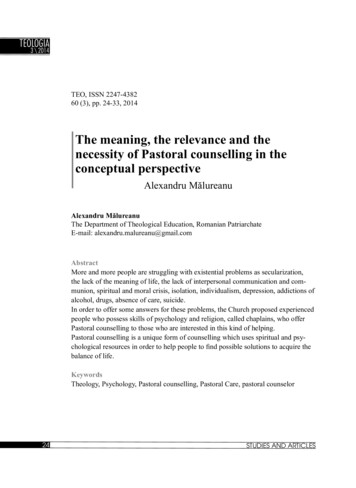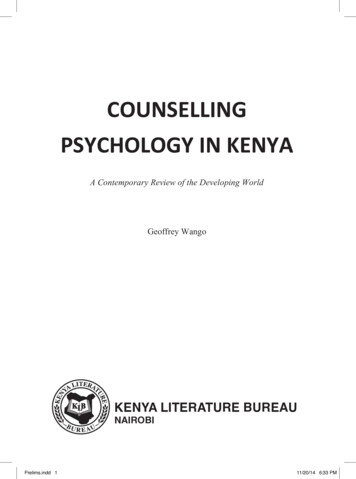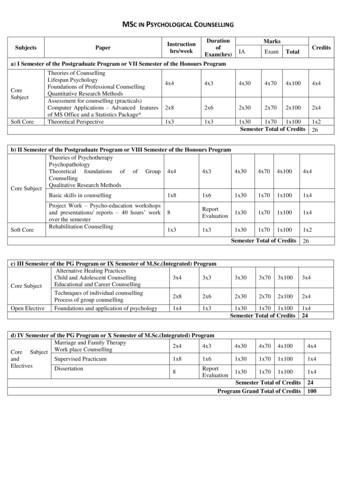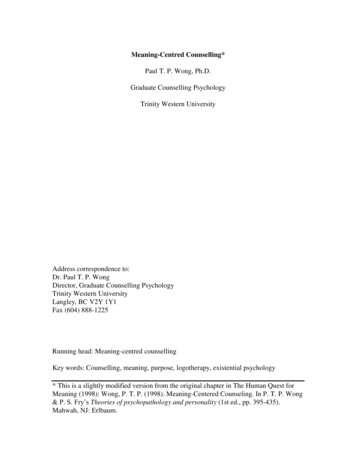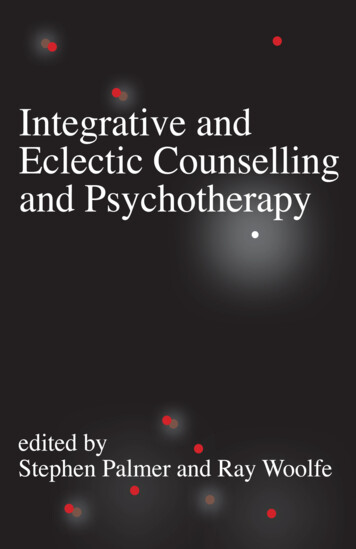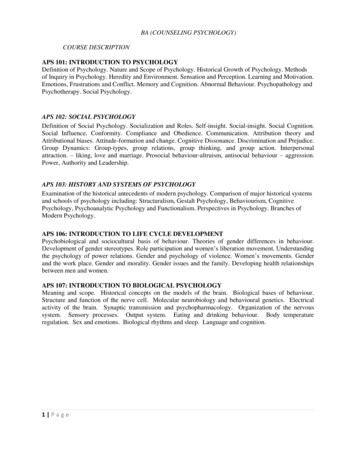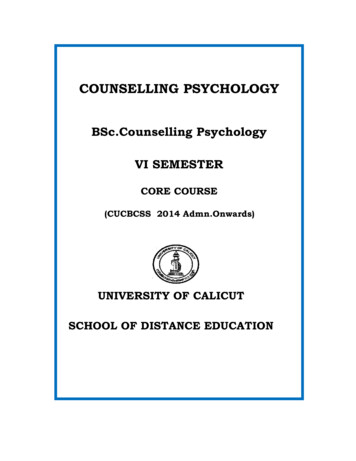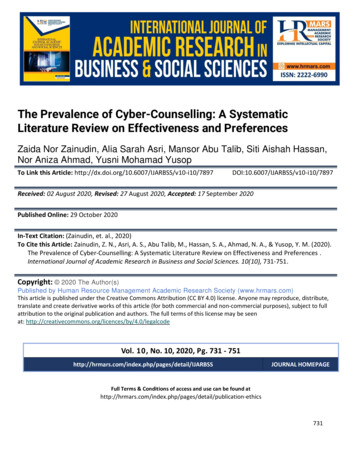
Transcription
International Journal of Academic Research in Business and Social SciencesVol. 1 0 , No. 10, 2020, E-ISSN: 2 2 2 2-6990 2020 HRMARSThe Prevalence of Cyber-Counselling: A SystematicLiterature Review on Effectiveness and PreferencesZaida Nor Zainudin, Alia Sarah Asri, Mansor Abu Talib, Siti Aishah Hassan,Nor Aniza Ahmad, Yusni Mohamad YusopTo Link this Article: 10.6007/IJARBSS/v10-i10/7897Received: 02 August 2020, Revised: 27 August 2020, Accepted: 17 September 2020Published Online: 29 October 2020In-Text Citation: (Zainudin, et. al., 2020)To Cite this Article: Zainudin, Z. N., Asri, A. S., Abu Talib, M., Hassan, S. A., Ahmad, N. A., & Yusop, Y. M. (2020).The Prevalence of Cyber-Counselling: A Systematic Literature Review on Effectiveness and Preferences .International Journal of Academic Research in Business and Social Sciences. 10(10), 731-751.Copyright: 2020 The Author(s)Published by Human Resource Management Academic Research Society (www.hrmars.com)This article is published under the Creative Commons Attribution (CC BY 4.0) license. Anyone may reproduce, distribute,translate and create derivative works of this article (for both commercial and non-commercial purposes), subject to fullattribution to the original publication and authors. The full terms of this license may be seenat: deVol. 10, No. 10, 2020, Pg. 731 - SJOURNAL HOMEPAGEFull Terms & Conditions of access and use can be found tion-ethics731
International Journal of Academic Research in Business and Social SciencesVol. 1 0 , No. 10, 2020, E-ISSN: 2 2 2 2-6990 2020 HRMARSThe Prevalence of Cyber-Counselling:A Systematic Literature Review on Effectiveness andPreferencesZaida Nor Zainudin, PhD, Alia Sarah Asri, Mansor Abu Talib,PhD, Siti Aishah Hassan, PhD, Nor Aniza Ahmad, PhD, YusniMohamad Yusop, PhDFaculty of Educational Studies, University Putra Malaysia, Serdang Selangor. MalaysiaEmail: zaidanor@upm.edu.my, gs53296@student.upm.edu.my, mansorat@upm.edu.my,siti aishahh@upm.edu.my, nor aniza@upm.edu.my, yusni my@upm.edu.myAbstractCyber-counselling, among its other names, is not at all new to the counselling field. Along with theemergence and advancement of computer-assisted technology, internet, and information andcommunications technology (ICT), the counselling field has also benefited from the use of onlineservices in providing counselling to all. It is no longer a rare topic to discuss, but now an importantarea of study and service that has the ability to reach out to all people across the globe. Hence thepurpose of this systematic literature review is to explore and discuss the prevalence of cybercounselling in reaching out to all possible clients and improving counselling experiences andoutcomes to all. Journal articles were selected primarily from the use of SCOPUS database for thepurpose of this review and its main objectives. The searching process started with a list of keywords“cyber counselling”, “online counselling”, “e-counselling”, “e-therapy” and “face-to-facecounselling”. The inclusion and exclusion criteria applied with limited from the year 2012 to 2019.The subject areas selected were Psychology, Social Sciences and Arts and Humanities. A total of 22articles were selected and included in this review study. The limitations in the use and delivery ofonline counselling were also reviewed which finally led to the discussion of implications of onlinecounselling as an alternative method to counselling.Keywords: Cyber-Counselling, Effectiveness, Preferences, Prevalence.IntroductionCyber-counselling, also called as e-counselling, web-counselling and e-therapy (Zainudin & Yusop,2018), has dated all the way back to the early 1960s with the development of computer. NationalBoard for Certified Counselors defined cyber-counselling as ‘‘the practice of professional counsellingand information delivery that occurs when client(s) and counsellor are in separate or remotelocations and utilize electronic means to communicate over the Internet’’ (Mishna, et al., 2015).732
International Journal of Academic Research in Business and Social SciencesVol. 1 0 , No. 10, 2020, E-ISSN: 2 2 2 2-6990 2020 HRMARSThe rapidly increasing rate in the use of internet and ICT among Millennium generation has becomea norm for all where it assists in obtaining information or in seeking help with health and relationships(Suzuki & Calzo, 2004). Simultaneously, the internet has provided counsellors with multiple methodsin building counselling relations with clients and these include the use of e-mails, online chatroom,video conferencing and online support group (Stefan & David, 2013; Murphy et al., 2009).According to Eisenberg et al. (2007); Al-krenawi et al. (2009); Heflinger and Hinshaw (2010) and Wonget al. (2018), the stigma among the Asian societies towards mental health problems are hinderingsome affected individuals from seeking for help. This, including the norms in Asian cultures that areless inclined towards self-disclosure, may be causing the 2.8 to 10 million individuals in Malaysia(Crabtree & Chong, 2000; Wong, et al., 2018), to not choose to seek for mental health support andhelp. This situation is similar as to the ‘negation effect’ (Glasheen, et al, 2016) which is experiencedby individuals who are facing severe psychological issues such as depression and social anxiety butare refusing to seek professional help. This negation effect and stigma on mental health problems,however, are able to make cyber-counselling a more viable and convenient option for affectedindividuals who may not consider seeking help through face-to-face counselling.For this particular reason, the online counselling is seen to be prevalent as a good alternative to faceto-face counselling for multiple reasons. The effectiveness in the use of both counselling methods areshown to be as equal (Stefan & David, 2013; Dunn, 2012; Holmes & Foster, 2012) while thepreferences toward either counselling methods are varied with slight or no significant differencesidentified. The preferences toward using online counselling can be explained by the sense ofanonymity, privacy and control that such counselling method has to offer the clients with (Dunn,2012; Campbell & Glasheen, 2012). A study by Glasheen et al,. (2015) among secondary schoolstudents showed that over 80% of the students are willing and preferred to use online counsellingservices if made available at school for different reasons such as their anonymity, as previouslymentioned.Hence, this paper is written to explore the prevalent use of cyber-counselling services to all possibleclients and to address the effectiveness and preferences toward such services over more traditionalcounselling methods such as face-to-face counselling. Even though the effectiveness of bothcounselling methods shows no significant differences, reviewer wished to explore the factors thatare making online counselling such a prevalent method to counselling and help-seeking in thistechnological era. This review paper also discussed the limitations that the reviewer believed to bechallenging the use and preferences of both clients and counsellors toward using online counselling,which will later allow for continual improvement in overall counselling services.The objective of this review is to investigate and explore the prevalent use of cyber-counselling.Hence the questions below will provide some of the main ideas and contexts that will be reviewed inthis study.1. What are the statistics of effectiveness and preferences toward cyber-counselling?To study this, reviewer will provide statistical data acquired from literature readings which illustratedboth the effectiveness and preferences toward online counselling.2. What is the prevalence that cyber-counselling services have over face-to-face counselling?733
International Journal of Academic Research in Business and Social SciencesVol. 1 0 , No. 10, 2020, E-ISSN: 2 2 2 2-6990 2020 HRMARSThe focus of this review is to discuss and explore some of the factors that make cyber-counselling aneffective and preferable, alternative counselling method.3. What are the patterns of factors that make prevalent of cyber-counselling as alternative andpreferable method of counselling?The factors asserted in the literatures used shall be concluded as the main factors that are makingcyber-counselling method preferable to some.4. What are the limitations that cyber-counselling services have over face-to-face counselling?To call for more improvement in the use of cyber-counselling services, some of their limitations willbe provided in this paper by reviewer.MethodologyThe systematic literature review was first initiated with the key word “cyber-counselling” and “etherapy”. Some other key words were also included so to limit the literatures to a smaller numberthat was further filtered to derive suitable and appropriate literatures. Hence, the objectives of thissystematic literature review serves as a guide when searching for literatures that are appropriate tothe main context in this review paper.The Search StrategyJournal articles were selected primarily from the use of SCOPUS database for the purpose of thisreview and its main objectives. The searching process started with a list of keywords “cybercounselling”, “online counselling”, “e-counselling”, “e-therapy” and “face-to-face counselling”. Acomplete list of keywords or search string for this study is tabulated in Table 2. The keywords usedwere able to extract as many as 117 articles in the initial searching process. Such reasonable numberof articles identified were possibly due to the specific list of keywords used, while at the same timemay also be due to the lack of research conducted on the topic.Next, the search was limited from the year 2012 to 2019 as to review some of the most recent journalarticles publication, where it was able to identify 81 articles. Then, the identified articles were alsoscreened according to their document or literature type by excluding book, book chapters, reviewarticle and conference proceedings or articles. The number of articles remained for selection afterthis exclusion process was 59 articles. Afterwards, only subject areas Psychology, Social Sciences andArts and Humanities were included in the article selection where articles selected were also inEnglish, which finally resulted to 51 articles. This searching method is known as to be the inclusionand exclusion criteria, which can be better described in Table 1, in order to search for the mostappropriate literature reading for this review.Finally, the remaining articles left were all reviewed for eligibility according to their titles and abstractthose were relatable to the content of this study. In the final selection process, a total of 22 articleswere selected and included in this review study. A complete article selection process is as shown inthe flow of systematic review process in Figure 1.734
International Journal of Academic Research in Business and Social SciencesVol. 1 0 , No. 10, 2020, E-ISSN: 2 2 2 2-6990 2020 HRMARSTable 1. Inclusion and Exclusion CriteriaCriterionEligibility (Inclusion)Publication years2012-2019DocumentResearch ArticleLanguageSubject AreaEnglishPsychology, Social Sciences,Arts & HumanitiesExclusion 2012Book, book chapter, reviewpaper, conference paperNon-EnglishComputer Science, MedicineTable 2. Search string used for systematic literature review processDatabase Key terms usedScopus“Cyber counselling” OR “cyber counseling” OR “online counselling” OR “onlinecounseling” OR “E-counselling” OR “E-counseling” OR “E-therapy AND “Face-to-Facecounselling” OR “face-to-face counseling”735
International Journal of Academic Research in Business and Social SciencesVol. 1 0 , No. 10, 2020, E-ISSN: 2 2 2 2-6990 2020 HRMARSFigure 1: Flow chart of systematic literature reviewFindingsThe selected journal articles from the search strategy are summarized as shown in Table 3. Theliteratures are presented by their authors, publication years, title of the articles in the journal, sampleof the study conducted and finally the findings in each literature that are relevant to the objectivesof this systematic literature review.Table 3. Summary of selected literaturesAuthor (Year)Title of Journal1Ballesteros, J. L.,& Hilliard, R. C.(2016). U.S.Based Latina/OCollegeStudents’Attitudes toward OnlineCounseling.Sample231 collegestudents.Age: 18 – 55yearsMale: 85Female: 146Relevant FindingsThe research showedfairly positive attitudesof US-based Latina/ocollege students towardboth online and face-toface counselling. Whilethere are slightly morepreferences toward736
International Journal of Academic Research in Business and Social SciencesVol. 1 0 , No. 10, 2020, E-ISSN: 2 2 2 2-6990 2020 HRMARS2Attitudes toward Faceto-Face and OnlineCounseling: Roles ofSelf-Concealment,Openness to Experience,Loss of Face, Stigma, andDisclosure Expectationsamong Korean CollegeStudentBlake-Buffini, K., One-to-one support for& Gordon, M. crisis intervention using(2014)online synchronousinstant messaging:evaluating workingalliance and clientsatisfaction228 volunteeredstudents whoenrolled inpsychologycoursesMale: 107Female: 1214Campbell, M. A., The Provision of Online& Glasheen, K. Counselling for Young(2012)PeopleSecondaryschool studentsand schoolcounsellors5Lan (2016)214 collegestudents withdisabilities inuniversities inTaiwan.Age(mean):21.11 years3Bathje, G. J.,Kim, E., Rau, E.,Bassiouny, M.A., & Kim, T.(2014).Predictors of Willingnessto Use Cyber Counselingfor College StudentsWith Disabilities78 participantswho have beendiagnosed withmental healthconditionAge: 18 yearsand overMale: 13Female: 65face-to-face counselling,they are less stigmatowards onlinecounselling whichexplains the positiveattitudes.Research showed lessnegative impact ofstigma on onlinecounselling and a slightlyor neutral attitudestoward onlinecounselling due to selfdisclosure expectations.Study indicated workingalliance as a predictor toclients’ satisfaction,whereby clients whowere previouslydiagnosed with mentalhealth issues showlower level ofsatisfaction from onlinecounselling as comparedto offline (face-to-face)counselling.Although the technologyhas been a primarymedium ofcommunication andinformation gatheringfor youth, the use ofonline counsellingservices is seen to notbe as much as beingused by adult.Cyber-counselling needsand cyber-counsellinghelp-seeking attitudesserve as determinantsfor willingness of collegestudents with disabilities737
International Journal of Academic Research in Business and Social SciencesVol. 1 0 , No. 10, 2020, E-ISSN: 2 2 2 2-6990 2020 HRMARSMale: 102Female: 112to use cyber-counsellingservices.Study conductedindicates that mostrespondents,psychologists who alsohad previously providedonline counselling, areshowing positiveattitude and morefavoritism towards usingthe online modalities.The study highlighted oncounsellors’ perceptionson online clientswhereby they havemultiple roles not onlyas counsellors, whilealso dealing with issuesbrought into online thatare mostly much moreserious and complex.Although lacking inphysical presence,features such as locus ofcontrol, anonymity,disinhibition and moretime to think in emailcounselling are shown tomake online counsellingan alternativecounselling method.The likeness of studentsto seek for help throughonline counselling areinfluenced by factorssuch as gender andlevels of psychologicaldistress.Three factors areexamined: initialengagement, developingrapport and establishing6Cipolletta, S., & Online counseling: AnMocellin,D. exploratory survey of(2017)Italian psychologists’attitudes towards newways of interaction388 ItalianlicensedpsychologistsAge: 27 – 80yearsMale: 48Female: 2417Dowling, M. J., & Experiences ofRickwood, D. J. Counsellors Providing(2014)Online Chat Counsellingto Young People.19 professionalonline mentalhealth cliniciansMale: 3Female: 168Dunn, K. (2012)13 participantsas clients.Age: 19-25 yearsMale: 3; Female:109A QualitativeInvestigation into TheOnline CounsellingRelationship: To Meet orNot to Meet, That Is TheQuestionGlasheen, K. J., Online Counseling inShochet, I., & Secondary Schools:Campbell, M. A., Would Students Seek(2016)Help by This Medium?10 Hanley, T. (2012)Understanding theOnline TherapeuticAlliance through The6 participants ascounsellors.Male: 1; Female:5215 secondaryschool studentsfrom schoolsMale: 103Female: 11215 secondaryschool students.Age: 11-15 yearsMale: 0738
International Journal of Academic Research in Business and Social SciencesVol. 1 0 , No. 10, 2020, E-ISSN: 2 2 2 2-6990 2020 HRMARSEyes of AdolescentService Users11 Harris, B.,Birnbaum,(2014)& Ethical and LegalR. Implications on the Useof Technology inCounselling.Female: 15-12 Holmes, C., & A PreliminaryFoster, V. (2012) Comparison Study ofOnline and Face-to-FaceCounseling: ClientPerceptions of ThreeFactors50 counsellingparticipantsAge: 18 andaboveMale: 11Female: 3913 Holmes, C. M., & A PreliminaryKozlowski, K. A. Comparison of Online(2015)and Face-to-FaceProcess Groups.Participants,who arecounsellingmaster students,are divided intotwo groups: 31in face-to-faceand 12 in onlineMale: 6 & 2Female: 25 & 1014 Wong, K. P., Preferences for OnlineBonn, G., Tam, C. and/or Face-to-Face409 studentsfrom sixcontrol, which influenceclient-service match ortherapeutic workingalliances through onlinecounselling.The study discussed onthe advantages of usingonline counsellingmodalities where scommunication) canalso be theirdisadvantages andbarriers to efficientcounselling sessions.The research analyzedthat the social presenceand working allianceconstructs in onlinecounselling are at leastsimilar to clients’experiences with faceto-face counselling.The study wasconducted with twogroups of participants:online and face-to-facegroup counselling.Results obtainedindicated that althoughworking alliancebetween the two groupsdoes not differsignificantly, participantsdo feel the lack of groupsafety, emotionalrelatedness and socialpresence in onlinesetting.The study indicated aslight preference toward739
International Journal of Academic Research in Business and Social SciencesVol. 1 0 , No. 10, 2020, E-ISSN: 2 2 2 2-6990 2020 HRMARSL. & Wong, C. P. Counseling among(2018)University Students inMalaysia15 Mishna, F., Bogo, Cyber Counseling:M., & Sawyer, J. Illuminating Benefits andL. (2015)Challenges16 Mishna, F., Bogo, Here to Stay: CyberM., Root, J., & Communication as aFantus, S. (2014) Complement in SocialWork Practice17 Nagarajan, M., & Mental healthS, Y. (2019)counsellors’ perceptionson use of technology incounsellinguniversities inMalaysia.Age: 16-35 yearsMale: 170Female: 23934undergraduatestudents.Age: 18 - 34Male: 3; Female:3124 MSW studentinterns.Age: 20 – 30Male: 2; Female:2216 counselingpsychologymaster studentsAge: 22.58 –43.25Male: 6Female: 1011 mental healthprofessionalsMale: 4Female: 7face-to-face counsellingalthough bothcounselling methodswere viewed positively.While student interns(as counsellors) felt thelack of body cues to bethwarting thecounselling process, thestudents (clients) feltthat techniques such as‘emotion bracketing’ arebeneficial.The study divided theparticipants into cofacilitating two supportgroups: online groupcounselling and face-toface group counselling.Participants were novicecounsellors who, fromthis study, perceivemore challenges whenconducting online groupcounselling.Study conducted showthat the participants,despite acknowledgingthe prevalent use oftechnology incounselling, mostlyprefer one-on-onemodalities due to thelack of training receivedand existed whencompensating thedisadvantages of theonline modalities.740
International Journal of Academic Research in Business and Social SciencesVol. 1 0 , No. 10, 2020, E-ISSN: 2 2 2 2-6990 2020 HRMARS18 Kit, P. L., Wong,S. S., D’Rozario,V., & Teo, C. T.(2014)Exploratory Findings onNovice GroupCounselors’ Initial Cofacilitating Experiences inIn-Class Support GroupsWith Adjunct OnlineSupport Groups16 counsellingpsychologystudents.Age: 22 – 44yearsMale: 6Female: 10The research conductedon 16 novice counsellorsimplied that participantsprefer face-to-facecounselling platform dueto the challenges theyfaced in online platform.19 Pordelan,N.,Sadeghi,A.,Abedi, M. R., &Kaedi, M. (2018)How online careercounseling changescareer development: Alife design paradigm45 studentsdivided intothree groups:online, face-toface and controlgroupAge: 20.60(Mean age)Male: 16Female: 29The study on online andoffline interventiongroups showed thatboth groups are able toimprove and enhanceclients’ careerdevelopment (whichconsists of careerdecision-making andcareer planning amongmany).The study showed thattherapeuticrelationships can bedeveloped through theonline environmentwhereby counsellors areable to adapt some ofthe skills they applied inface-to-face counsellingto online.20 Salleh,A., Online counseling usingHamzah,R., email: A qualitative studyNordin,N.,Ghavifekr, S., &Joorabchi, T. N.(2015)21 Stefan, S., &David, D. (2013)Face-to-Face Counselingversus High DefinitionHolographic ProjectionSystem. Efficacy andTherapeutic Alliance. ABrief Research Report6 qualifiedcounsellorsAge: 35 – 49yearsMale: 3; Female:359 volunteerclientsAge: 20 – 55Male: 12;Female: 4756undergraduatePsychologystudents.Age: 20-44 yearsMale: 7Female: 49The study concludedthat no significantdifferences are shown ineffectiveness ofreducing distress andirrational beliefs(through the use oftheory REBT), as well asthe presence oftherapeutic workingalliance through bothcounselling methods.741
International Journal of Academic Research in Business and Social SciencesVol. 1 0 , No. 10, 2020, E-ISSN: 2 2 2 2-6990 2020 HRMARS22 Tse,S., Face-to-Face andCampbell,L., Telephone CounselingRossen,F., for Problem GamblingWang,C.-W.,Jull, A., Yan, E., &Jackson,A.(2012)92 participantswho are facinggamblingproblemAge: 16 andaboveMale: 30Female: 62The study conductedonline and telephonecounselling towardsparticipants withgambling issues.Findings indicated thatboth face-to-face andtelephone interventionshow similar clinicaloutcomes for clientswith specific issues.DiscussionThe Statistics of Effectiveness and Preferences toward Cyber-CounsellingThe statistical or relevant data on the effectiveness and preferences toward cyber-counselling areshown in Table 4.Table 4. Statistical or relevant data from selected studiesLiteratureStatistical or Relevant Data1Regardless of gender, there are slightly more preferences toward faceto-face counselling modalities.2Students show slightly positive or neutral attitudes toward onlinecounselling.3The use of online counselling in psychotic clients is seen to be lessefficient when related to the lower level of working alliance andsatisfaction as compared to the traditional, offline setting.4There is a lack of, or absence of, evidence of online counselling servicesbeing actively provided at schools in Australia.5Highest score is obtained in career domain issues in cyber-counsellingneeds, resulting to high willingness to accept cyber-counseling servicesin the said needs.6Most of the respondents who are psychologists and had previouslyprovided online counselling are more favorable towards using theonline modalities.7Online mental health practitioners are showing diverse perceptions ononline clients whereby they are responsible with many different roles inthe counselling relationship.8Email counselling is considered to be as effective as face-to-facecounselling method.980% of female and over 84% of male secondary school studentsindicated that they might, or would likely to use online counsellingservices if available.742
International Journal of Academic Research in Business and Social SciencesVol. 1 0 , No. 10, 2020, E-ISSN: 2 2 2 2-6990 2020 HRMARS10111213141516171819202122Young people are able to develop good therapeutic working alliancewith counsellors through online counselling.Online counselling is suggested to be provided in conjunction with faceto-face counselling for more effective outcomes.Most online counselling clients perceived a significantly strongeralliance in the Goal subscale analysis than they did in face-to-facecounselling.Online group counselling is seen to be lacking in social presence ascompared to face-to-face group counselling.35% of the participants are more receptive towards only using onlinecounselling services.53% out of 64 undergraduate students participated in the researchchose to receive online counselling.Participants indicated more preferences toward face-to-face groupcounselling than online.6 out of 11 participants prefer one-on-one modalities when providingcounselling due to some of the limitations and challenges of the onlinesetting.75% of the novice counsellors had positive experiences when cofacilitating online group counselling.Both online and face-to-face interventions are effective in improvingclients’ career development, hence indicating positive outcome for bothcounselling modalities.Therapeutic relationship is able to develop through onlinecommunication.As small as 4% of differences are shown in the effectiveness and thepresence of therapeutic working alliance via both face-to-facecounselling and videoconference counselling.Both face-to-face and telephone counselling modalities produce equallyeffective short-term clinical outcomes.Prevalence of Cyber-Counselling over Face-to-Face CounsellingAccording to the reviewed literature readings, it is shown that the use of cyber-counselling is indeedpreferred for some, and has the potential to become an alternative counselling method to face-toface counselling. In fact, it is proven that the effectiveness of cyber-counselling is as equal to the moretraditional face-to-face counselling with slight or no significant differences (Glasheen, et al., 2016;Dunn, 2012; Stefan, & David, 2013; Holmes, & Foster, 2012).The research conducted on 24 MSW student interns who are providing cyber-counselling services to24 undergraduate students in a 4 academic years span proved cyber-counselling method to be bothbenefiting and challenging to counsellor interns and clients for its accessibility, written word or text,emotions conveyed and online disclosure. The undergraduate clients, through this research, reported743
International Journal of Academic Research in Business and Social SciencesVol. 1 0 , No. 10, 2020, E-ISSN: 2 2 2 2-6990 2020 HRMARSthat cyber-counselling offered them with opportunities to re-read their responses which then enablethem to self-reflect.A different research by Holmes & Foster (2012) also showed that while online counselling clientsshow no differences in working alliance from the Task and Bond subscale analyses, they neverthelessshowed a stronger alliance towards the Goal subscale analysis. This indicated the ability oftelecommunication through computer-assisted communication and as Holmes, & Foster, (2012)explained, “[the effectiveness of online therapy] in setting agreed upon and clear goals between thecounselor and client due to the written nature of the sessions”. This is also similar to the researchconducted by Stefan & David (2013) which resulted with the Goal Agreement component to beshowing a significant advantage through the use of advanced videoconference system, EONHolopodium. Both researches by Holmes & Foster (2012) and Stefan & David (2013) concluded,respectively, that both face-to-face and online counselling are at least equal in their effectiveness inbuilding and forming strong social presence and working alliance, as well as reduction in generaldistress and irrational beliefs. However, it should also be noted that a study by Blake- Buffini &Gordon (2014) contradicts to this when the results indicated lower level of working alliance, which isa predicator to lower level of satisfaction, in psychotic clients as compared to the offline or face-toface counselling setting. A study by Holmes & Kozlowski (2015) on comparison of online and face-toface group counselling also indicated that despite the improved of social presence through the useof videoconferencing, participants nevertheless perceived a lack of social presence and emotionalrelatedness in online group counselling as compared to the more traditional modalities.Nevertheless, the research conducted using the CBT approach (Barak et al., 2008, Stefan & David,2013), also demonstrated the effectiveness of online interventions on clients with disorders such aspanic, anxiety, PTSD and smoking cessation. Glasheen, et al., (2016) showed that young people facingsevere psychological distress are more inclined in using online counselling as a medium for helpseeking. The very foundation of anonymity and privacy in online counselling services are most likelythe reasons that they prefer to seek help through online communication, hence making such methodas powerful tool in overcoming the ‘negation effect’ (Rickwood, et al. 2005; Glasheen, et al., 2016).This is also consistent with a study by Nagarajan & Yuvaraj (2019) whereby counsellors perceiveanonymity, convenience and accessibility to be important factors that attract online clients.A research on males suffering from addictions also implied that online counselling may be morepreferable to them for the sense of anonymity and privacy that the online method offered them with(Campbell & Glasheen, 2012). In fact, this sense of anonymity has become one of the main benefitsthat online counselling possesses, where it gives more control to the clients especially for those whoare facing the feeling of embarrassment when experiencing face-to-face therapy (Campbell &Glasheen, 2012; Hanley, 2012). Hence, it is to no surprise that the ‘disinhibitation effect’ offered inonline counselling enable
cyber counselling, online counselling, e-counselling, e-therapy and face -to-face counselling. The inclusion and exclusion criteria applied with limited from the year 2012 to 2019. The subject areas selected were Psychology, Social Sciences and Arts and Humanities. A total of 22 articles were selected and included in this review study.



